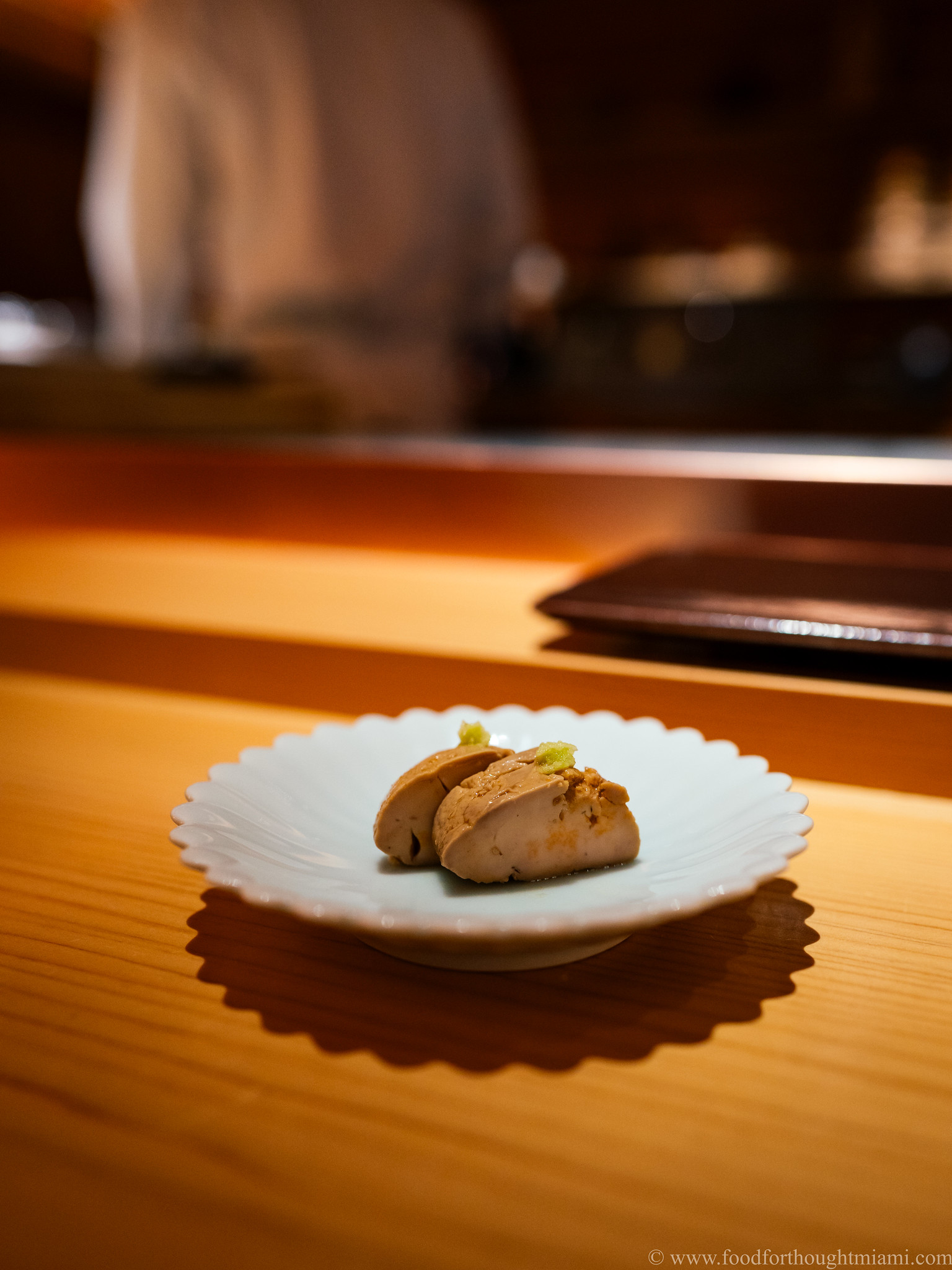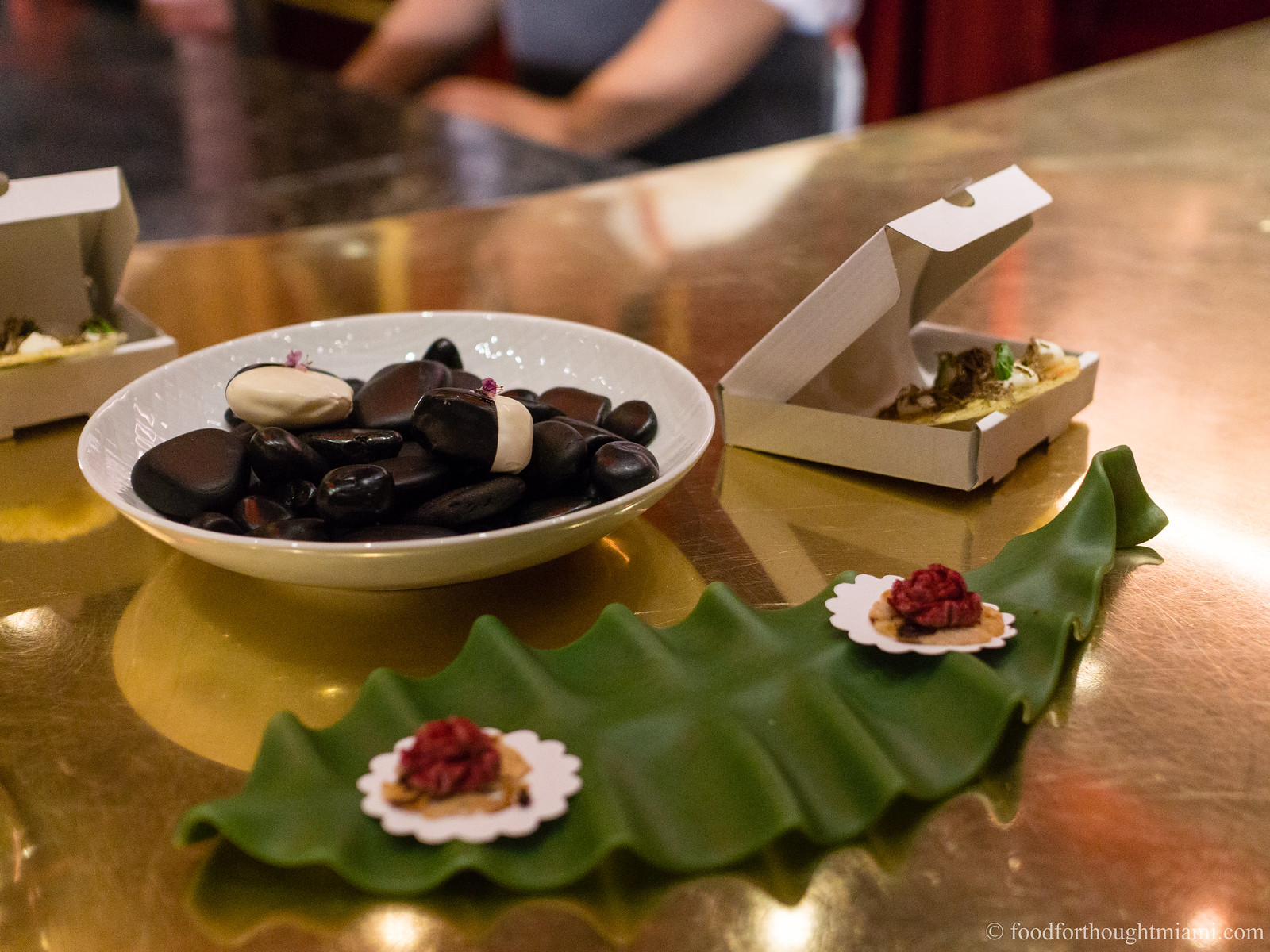
I did something on my last trip to Las Vegas that I'd never done before. No, I did not split 10s against a dealer's ace at the blackjack table. I didn't pass out and wake up with Mike Tyson's lion in my room. Nor did it involve any of the fine ladies whose cards are handed out on the strip in the evenings. No, this was something really unusual for me: during a four-day trip, I went back to the same restaurant twice.
There were a number of places on my "hit list" for this Vegas trip, but after going to
Aburiya Raku late on the night we arrived, some of the list had to be thrown out. A repeat visit violates one of my basic travel rules, but this is really my kind of place.
Though I'd hazard a guess that roughly 99% of the visitors to Las Vegas have never heard of the restaurant, it has hardly escaped notice. It was a semifinalist this year for the James Beard Foundation's Best New Restaurant Award, has been much talked up by
various bloggers, and is a favorite of local chefs (who must also appreciate that it is open till 3am). The focus is on charcoal-grilled robata style items, but the menu ranges well beyond that and features a broad variety of izakaya-style small dishes. The ingredients are immaculate, and the preparations are precise and loaded with flavor.
About 15 minutes off the strip on West Spring Mountain Road, Raku is situated in a nondescript little strip mall, next door to a dingy-looking Korean BBQ place. But once you step inside, a different atmosphere takes over. It's a much smaller place than I anticipated, only about 8 tables total plus a a small bar (I've heard an expansion is in the works), subtle halogen lighting, dark walls, and pretty blond wood tables. The waitstaff are friendly, charming and eager to talk through the menu as well as a long list of daily specials. Those specials include a number of fresh seafood items, many flown in from Japan.
On our first visit, my dining companion and I started off small, ordering about 3-4 things mostly from the specials. After about four more rounds of ordering, we had happily worked our way through a good portion of the menu. We began simply, with Tofu Two Ways (this "two way" option was a common theme among many of the specials, which is a great idea). First came simple cold tofu hiyayakko, with accompaniments of slivered scallion, minced ginger, and katsuobushi (dried bonito) flakes. The house-made tofu was a revelation, with a luxurious creamy texture and a light, milky, slightly nutty flavor. Our server recommended using a dash of the green tea salt with it, which brightened and enhanced the flavors. The second take on it was agedashi style, the tofu fried and lightly crispy on the outside, in a warm pool of soy-stained dashi broth dotted with scallions and little honshimeji (beech mushrooms), and topped with a generous dollop of ikura (salmon roe) and julienned strips of nori.
From the specials we also had Asari Sakamushi, small clams simply steamed in a sake broth. They had a deliciously pure seafood flavor, and the broth, rich with clam liquor, was just as good. Also from the specials we had Unagi Two Ways: the eel was presented with the two filets side-by-side (cut into roughly two-inch pieces for ease of handling), one side dabbed with wasabi, the other with the more traditional sweet-soy "barbecue" glaze. It was tender and meaty, and I just barely preferred the simpler wasabi preparation, which allowed the eel's flavor to come through more cleanly.
Next, a cold dish, Poached Egg with Sea Urchin, with the gooey egg (reminiscent of an immersion circulated 63C egg) in a thick, slightly sweet soy-based broth, along with tongues of uni, more ikura, tiny cubes of sticky yamaimo (mountain yam) and diced scallion. This seemed as much a meditation on slippery textures as it was about the flavors, and it was something of an adventure to go after this with chopsticks. Shortly after that came one of my favorite items of the night, a Foie Gras Chawan Mushi,
[1] the quivering dashi-inflected egg custard elevated by the rich earthy perfume of the duck liver.
From there we moved into our robata phase, which we divided into animal themes. We started with Kurobata Pork Cheek and Pork Ear. The cheeks were just delicious, meaty but tender and loaded with porky flavor. The ears (which our server recommended anointing with a chile-infused vinegar on the table) were chewy with a hint of crisp on the outside, and that visceral toothy bite from the strip of cartilage in the middle.
Next, a beef round, for which we tried the "Kobe" Beef Filet with Wasabi, and the "Kobe" Beef Tendon.
[2] I usually don't get that excited by beef filet cuts, which I generally find lacking in character. But this was so tender and luxurious, almost silky, its flavor brightened by the dab of wasabi, that it overcame my usual scorn for the tenderloin. But possibly the single greatest bite of the evening was the beef tendon. I'd never seen tendon grilled before, and this arrived as basically quivering cubes of beef jell-o, just barely in solid form, and with a rich, buttery "essence of beef" flavor. If you like bone marrow, you'll really like this. If you don't like bone marrow, well ... never mind.
We closed out the robata phase of our meal with a poultry round, featuring chicken breast with skin (terrifically moist and flavorful), tsukune (ground chicken, suprisingly one of the few items that didn't really excite, even though our server said it was a house specialty), and duck with balsamic soy sauce (also very good). Not quite ready to be done yet, we closed out with onigiri (grilled rice ball) in a dashi broth, topped with "bonito guts." This none-too-appealing translation (I think the Japanese word for it is "shuto") refers to an item that is similar to shiokara, salted and fermented fish innards, which I've previously only seen done with squid. I actually found it much milder than shiokara which I've tried before, and it gave a pungently salty, funky tweak to the rice and dashi broth.
According to
Wikipedia, "shuto" means "steal sake," supposedly in reference to the commonly held belief that it is good to drink sake with such things. Whether or not that's true, we did have some good sake with our meal. I don't know my sakes that well, but I am intrigued by the richer tasting, cloudy nigori style sakes, so we tried a couple. We started with a small bottle of a Tozai Nigori ("Snow Maiden", I think), which I found a bit too sweet for my taste. Even better was the Kamoizumi "Summer Snow," which was much more balanced and nuanced. The sake, and several of the food items, were enhanced by beautiful ceramic sake cups and dishes. Despite the somewhat casual atmosphere and the (generally) low prices, the presentations were in many ways quite elegant.
On the return visit a few nights later, we re-sampled several items to equal acclaim, and also tried a few different specials (an almost completely new list from our last visit). Though we had made a reservation, it was nearly a half hour after our reserved time when a table finally cleared. I understand that for early reservations they do now put a time limit on the tables, though I can see how that can be somewhat difficult to enforce in the moment (and if I was one of those earlier diners, I can empathize with not wanting to leave). When we finally sat, they assuaged us with a free pitcher of Sapporo, some nice crispy salted shrimp (which can be downed heads, shells and all), and some tiny little whole fried icefish. It worked.
Grilled salmon belly was luscious and decadent, rich with fatty fish oils underneath the nicely crispy skin. A special mackerel was one of the biggest I had ever laid eyes upon served whole, simply grilled and served with daikon oroshi. I actually might prefer smaller fish, as this was a bit dryer than I like, missing some of the oily texture of these "blue-skinned" fish that I enjoy. And we were completely taken in when we saw another table get a Kobe-style steak flambeed with brandy and cooked on a hot stone, ishiyaki style. Meat - fire - hot rocks? The caveman in us insisted.
A few things worth noting: (1) it is a very small place, and I suspect that reservations are a must; going later is probably better than going earlier, so as to avoid hungry people hovering and waiting for you to relinquish your table; (2) though most of the items on the regular menu are incredibly reasonably priced (many of the robata items, like the pork cheek, the chicken breast, and the beef tendon, are $3 and under, and both the foie gras chawan mushi and the poached egg with uni were under $10), some of the specials can be quite steep (the unagi and mackerel were both $30+, the steak ishiyaki was $60); if you're concerned, just ask; (3) this is a place worth breaking rules for.
Aburiya Raku5030 W. Spring Mountain Road
Las Vegas, NV
702.367.3511











